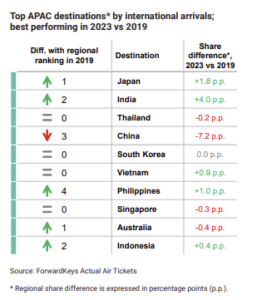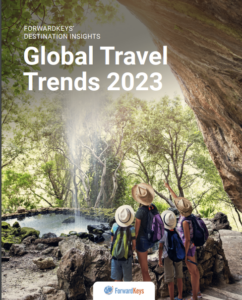International. A major travel trends report produced by travel data analyst ForwardKeys has identified top destinations to visit in 2024. – Middle East and Africa and South America.
The 2023 Global Travel Trends Report, released today, explores the emerging patterns of global tourism and evolving traveler behavior that will shape the industry through 2023.
This year has marked a significant milestone, with many destinations and travel businesses still focusing on recovering from the impact of COVID-19.
While the pace of recovery varies by region, it is expected to be complete by the end of 2024, even in countries that have recently lifted travel restrictions.
In 2022, the Caribbean and Southern Europe were the most popular destinations, as demand for 'sun and beach destinations’ increased international tourist arrivals. However, in 2023, very different travel patterns emerge.
The Dominican Republic, Mexico and Greece maintain high positions, but the mix is more diverse overall, with the Middle East and Africa (MEA) well represented among the top performers.
This year, Colombia ranks second, surpassing 2019 levels for international tourist arrivals by 5%. This represents a return to growth and a significant improvement compared to its counterparts in South America. This growth is attributed to the country’s improving reputation for tourism safety combined with relatively high affordability and substantial connectivity improvements.
The main trend identified in 2023 is the rise of urban tourism, a shift from the previous two years when there was a clear preference for sun and beach destinations, the report identified.

Click on the image to expand the table

Click image to enlarge
The picture changed in 2023 when tourism to urban destinations was on the rise – with 52% growth over 2022 levels, significantly outstripping sun and beach destinations, which had 26% growth over the same period.
The report found that despite extreme temperatures, wildfires and floods due to climate change in the summer of 2023, such factors had „no significant impact on travel patterns”.
Nevertheless, climate change is expected to have a long-term effect on travel preferences. As temperatures rise, summer demand in warmer locations is likely to decrease, while cooler regions become more attractive to travelers.
The Asia Pacific region has seen a rapid recovery in demand for luxury travel experiences compared to conventional travel.
This suggests that despite cost of living concerns, consumers are still willing to pay more for high-end travel experiences.
Other trends include family group travel where three to five passengers travel together. It has seen rapid recovery in all regions, particularly in the US, which is already surpassing pre-Covid 2019 levels.
Olivier Ponti, VP of Insights at ForwardKeys, said: “In 2023, many destinations and travel businesses focused on recovering post-Covid-19. The pace of that recovery will vary by region, but will be complete by the end of 2024, even in countries that have most recently lifted travel restrictions.
„It brings destinations back to issues they dealt with pre-pandemic. Where do they want to go with tourism? What kind of tourism? For what purpose? But even as the questions persist, the context has changed, shaped by geopolitical events, technological advances and increasing concerns about sustainability.
Noting that „growth at all costs” is no longer possible, he added: „Destinations and travel businesses must focus on new models of socially, economically and environmentally responsible tourism. In this context, access to accurate, timely and granular travel data is invaluable to success. ✈

. „Gracz. Namiętny pionier w mediach społecznościowych. Wielokrotnie nagradzany miłośnik muzyki. Rozrabiacz”.


